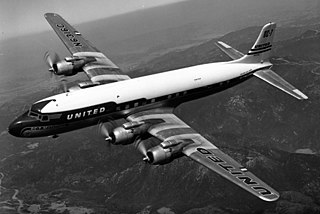
An aviation accident is defined by the Convention on International Civil Aviation Annex 13 as an occurrence associated with the operation of an aircraft, which takes place from the time any person boards the aircraft with the intention of flight until all such persons have disembarked, and in which (a) a person is fatally or seriously injured, (b) the aircraft sustains significant damage or structural failure, or (c) the aircraft goes missing or becomes completely inaccessible. Annex 13 defines an aviation incident as an occurrence, other than an accident, associated with the operation of an aircraft that affects or could affect the safety of operation.

The Douglas DC-7 is an American transport aircraft built by the Douglas Aircraft Company from 1953 to 1958. A derivative of the DC-6, it was the last major piston engine-powered transport made by Douglas, being developed shortly after the earliest jet airliner—the de Havilland Comet—entered service and only a few years before the jet-powered Douglas DC-8 first flew in 1958. Unlike other aircraft in Douglas's line of propeller-driven aircraft, no examples remain in service in the present day, as compared to the far more successful DC-3 and DC-6.
This is a list of aviation-related events from 1994.

Capital Airlines was an airline serving the eastern, southern, southeastern, and midwestern United States. Capital's headquarters were located at Washington National Airport across the Potomac river from Washington, D.C., where crew training and aircraft overhauls were also accomplished. In the 1950s Capital was the fifth largest United States domestic carrier by passenger count after the Big Four air carriers.

Pilot error generally refers to an accident in which an action or decision made by the pilot was the cause or a contributing factor that led to the accident, but also includes the pilot's failure to make a correct decision or take proper action. Errors are intentional actions that fail to achieve their intended outcomes. The Chicago Convention defines the term "accident" as "an occurrence associated with the operation of an aircraft [...] in which [...] a person is fatally or seriously injured [...] except when the injuries are [...] inflicted by other persons." Hence the definition of "pilot error" does not include deliberate crashing.

In an internal combustion engine, fuel starvation is the failure of the fuel system to supply sufficient fuel to allow the engine to run properly, for example due to blockage, vapor lock, contamination by water, malfunction of the fuel pump or incorrect operation, leading to loss of power or engine stoppage. There is still fuel in the tank(s), but it is unable to get to the engine(s) in sufficient quantity. By contrast, fuel exhaustion is an occurrence in which the vehicle in question becomes completely devoid of usable fuel, with results similar to those of fuel starvation.

Scandinavian Airlines System Flight 933 was a scheduled international flight from Denmark to the United States that on January 13, 1969, crashed into Santa Monica Bay at 19:21, approximately 6 nautical miles (11 km) west of Los Angeles International Airport (LAX) in California, United States. The crash into the sea was caused by pilot error during approach to runway 07R; the pilots were so occupied with the nose gear light not turning green that they lost awareness of the situation and failed to keep track of their altitude. The Scandinavian Airlines System (SAS) aircraft had a crew of nine and 36 passengers, of whom 15 died in the accident. The flight originated at Copenhagen Airport, Denmark, and had a stopover at Seattle–Tacoma International Airport, where there was a change of crew. The crash was similar to Eastern Air Lines Flight 401. The crash site was in international waters, but the National Transportation Safety Board carried out an investigation, which was published on July 1, 1970. The report stated the probable cause as improper crew resource management and stated that the aircraft was fully capable of carrying out the approach and landing. The aircraft was conducting an instrument approach, but was following an unauthorized back course approach.
In aeronautics, loss of control (LOC) is the unintended departure of an aircraft from controlled flight, and is a significant factor in several aviation accidents worldwide. In 2015 was the leading cause of general aviation accidents. Loss of control may be the result of mechanical failure, external disturbances, aircraft upset conditions, or inappropriate crew actions or responses.

Alaska Airlines Flight 779 was a contract cargo flight operated on 21 July 1961 by an Alaska Airlines Douglas DC-6A that crashed short of the runway at Shemya Air Force Base with the loss of all six crew members on board.







